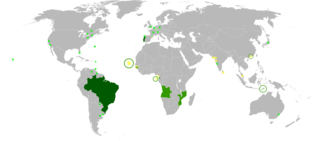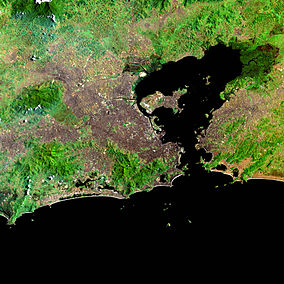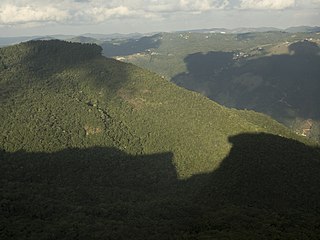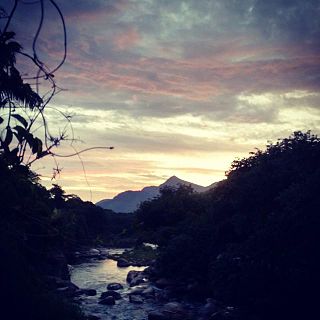| Guapimirim Environmental Protection Area | |
|---|---|
| Área de Proteção Ambiental de Guapimirim | |
IUCN category V (protected landscape/seascape) | |
Rio de Janeiro. The protected area is in the upper right. The mangroves are dark green. | |
| Nearest city | Magé, Rio de Janeiro |
| Coordinates | 22°43′12″S42°59′38″W / 22.720°S 42.994°W Coordinates: 22°43′12″S42°59′38″W / 22.720°S 42.994°W |
| Area | 13,926 hectares (34,410 acres) |
| Designation | Environmental Protection Area |
| Created | 25 September 1984 |
Guapimirim Environmental Protection Area (Portuguese : Área de Proteção Ambiental de Guapimirim) is a coastal marine protected area on Guanabara Bay in the state of Rio de Janeiro, southeastern Brazil.

Portuguese is a Western Romance language originating in the Iberian Peninsula. It is the sole official language of Portugal, Brazil, Cape Verde, Guinea-Bissau, Mozambique, Angola, and São Tomé and Príncipe. It also has co-official language status in East Timor, Equatorial Guinea and Macau in China. As the result of expansion during colonial times, a cultural presence of Portuguese and Portuguese creole speakers are also found in Goa, Daman and Diu in India; in Batticaloa on the east coast of Sri Lanka; in the Indonesian island of Flores; in the Malacca state of Malaysia; and the ABC islands in the Caribbean where Papiamento is spoken, while Cape Verdean Creole is the most widely spoken Portuguese-based Creole. Reintegrationists maintain that Galician is not a separate language, but a dialect of Portuguese. A Portuguese-speaking person or nation is referred to as "Lusophone" (Lusófono).

Guanabara Bay is an oceanic bay located in Southeast Brazil in the state of Rio de Janeiro. On its western shore lies the cities of Rio de Janeiro and Duque de Caxias, and on its eastern shore the cities of Niterói and São Gonçalo. Four other municipalities surround the bay's shores. Guanabara Bay is the second largest bay in area in Brazil, at 412 square kilometres (159 sq mi), with a perimeter of 143 kilometres (89 mi).

Rio de Janeiro is one of the 27 federative units of Brazil. It has the second largest economy of Brazil, with the largest being that of the state of São Paulo.






















